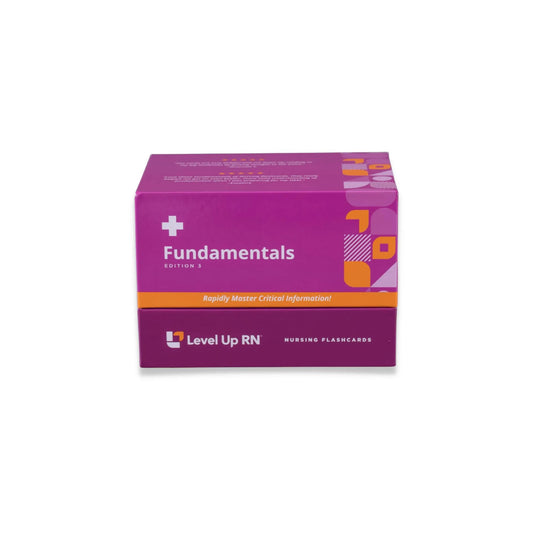When you see this Cool Chicken, that indicates one of Cathy's silly mnemonics to help you remember. The Cool Chicken hints in these articles are just a taste of what's available across our Level Up RN Flashcards for nursing students!
In this article, you'll learn about the major patient positions like supine, prone, all three Fowler's, Lateral, Trendelenburg and reverse Trendelenburg, lithotomy. You'll also learn about Sims' position and why we want to change its name.
The Fundamentals of Nursing video series follows along with our Fundamentals of Nursing flashcards, which are intended to help RN and PN nursing students study for nursing school exams, including the ATI, HESI, and NCLEX.
Fundamentals of Nursing - Flashcards
What is patient positioning?
Patient positioning is assisting patients to move their bodies into specific positions that maintain a safe and healthy body alignment, provide optimal exposure to treatment sites, and/or prevent complications from immobility.
Before you learn about patient positioning, it might seem like one of those obvious things you never really think about. Can open heart surgery be performed while someone is lying on their front? Probably not. But as you will learn, there is a science to positioning patients optimally depending on circumstances, conditions, and medical procedures.
Supine position
Supine position is your patient lying on their back in a neutral back. Neutral back means that the neck, pelvis, or otherwise are not twisted in any direction or hyperextended.
Prone position
Prone position is your patient lying on their stomach in a neutral position. Their head will usually be to one side or the other, but there are special pillows or shelves available so that patients can have a truly neutral neck and upper spine (i.e., be "facedown") if that is required.
Prone position helps prevent hip flexion contractures in patients who have had lower extremity amputations, and improves oxygenation in respiratory distress.
Semi-Fowler's position
Semi-Fowler's is when your patient is sitting up, but they are at an angle between 30 and 45 degrees.
A little geometry reminder: 0 degrees is flat (which would be supine), and 90 degrees is straight up (e.g., sitting up in a chair). So 45 degrees is about halfway between that.
Fowler's position
In Fowler's position, your patient is sitting up with the head of the bed between 45 and 60 degrees.
Who was Fowler? Fowler's position is named for George Ryerson Fowler, a turn-of-the-century American surgeon. Fowler performed many abdominal surgeries, and noticed that accumulated drainage under the diaphragm was causing sepsis in patients who were lying down. Sitting his patients up allowed gravity to assist with safer drainage.
High Fowler's position
In high Fowler's position, your patient is sitting straight up with the head of the bed between 60 to 90 degrees. This is the ideal position to help with difficulty breathing.
This is one of the easiest interventions you can give to a patient who is having respiratory distress, and it is very noninvasive and safe.
Lateral position
Lateral position is your patient lying on their left or right side, with their weight on their hip and shoulder.
Exaggerated runner's position / Sims' position / modified left lateral recumbent position
Exaggerated runner's position / Sims' position is a mix of lateral and prone position. The patient is lying on their left side, their leg is extended, their right leg is flexed at the hip. This position is ideal for enema administration.
The name Sims' position comes from J. Marion Sims, who was a surgeon in the 1800s who became known as "the father of modern gynecology." However, Sims only knew what he knew about gynecology by experimenting on enslaved women, without their consent, and without anesthesia, using experimental methods.
It is important when you provide culturally competent care, to think about how history impacts how we know medicine, how we practice medicine, and how we interact with our patients.
In your clinical practice, exaggerated runner's position is a good term to use because it does not have an offensive and upsetting history, unlike the Sims' position. Exaggerated runner's position is useful because it reflects how the position actually looks, like someone running in bed.
Your facility may still use the term Sims' position. Nurses are advocates, so if you are interested in making this change in your facility, we encourage you to advocate for a new name for the position.
Trendelenburg position
In the Trendelenburg position, the bed is flat, but tilted back, so the head of the bed is lower than the foot of the bed.
Trendelenburg position is ideal for patients with hypotension, especially if they have shock. However, Trendelenburg position should not be used for a long time, because it can increase the intracranial pressure due to the blood rushing back to the head.
Check out our Lab Values Flashcards for Nursing Students to learn more about expected intracranial pressure levels.
Reverse Trendelenburg position
In the reverse Trendelenburg position, the bed is flat, but tilted forward, so the head of the bed is higher than the foot of the bed. In this position, gravity helps lower the risk of gastroesophageal reflux.
Lithotomy position
Lithotomy position is when your patient is lying supine, but their legs are flexed and abducted. This is what you would see for a patient who is having a gynecologic, rectal, or urological procedure.



4 comments
thank you so much for your nice explanation
A nice wonder full education page keep it up thanks
Thank you so much for your awesome explanation.
Nice explanation madam thank you so much !!! Exlent